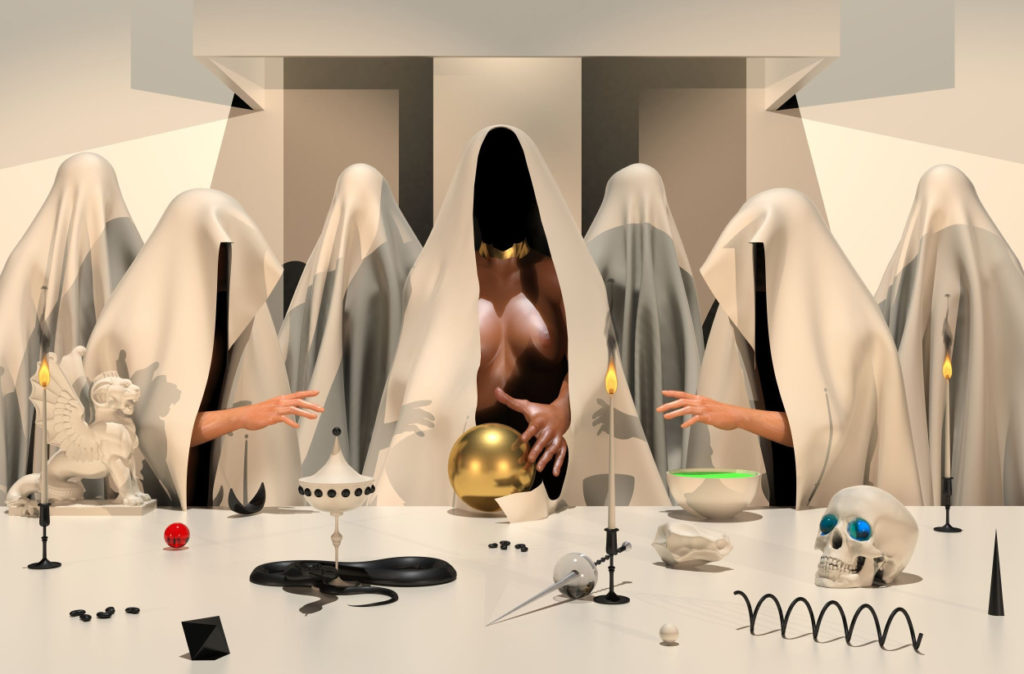George Crîngaşu
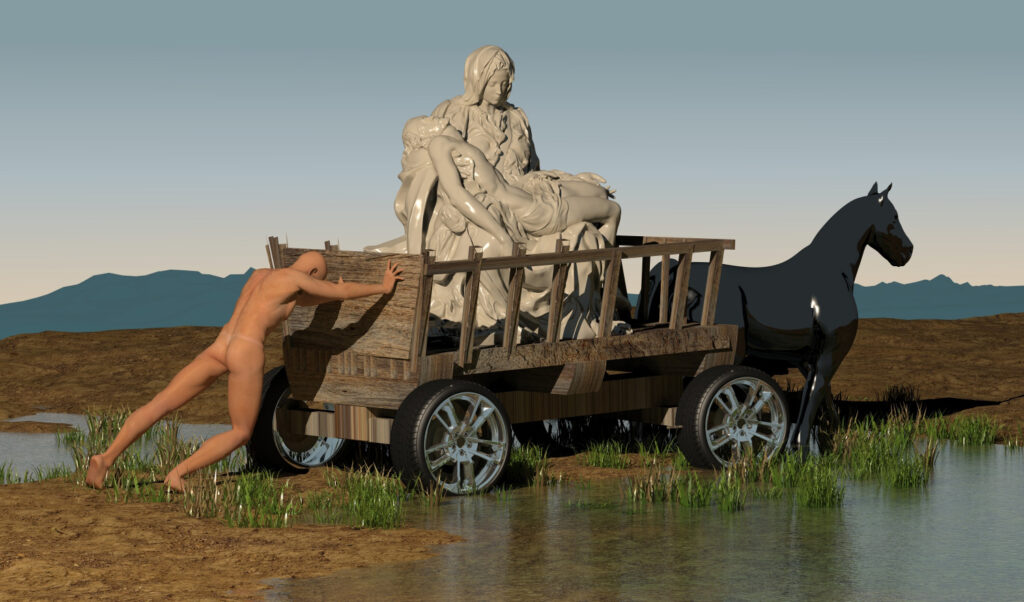
*Part of an Interview Series Taken by Sabin Borş in 2018
George Crîngașu’s work ranges from installation to animated gifs, and it is mostly comprised of 2D and 3D compositions build on freely available content found rummaging through various corners of the internet. Re-assembling bits and pieces of data gives him a feel of participating in the sort of entropic nature information seems to rely on: any type of data should be perpetually in motion and perpetually in a state of change.
Sabin Borş: How did you first start working with digital content and/or the Internet as a medium?
George Crîngaşu: If we are talking about the very first time I got a small kick out of finding how things work visually on a computer, I would have to say that it was way back when I first saw MS Paint on someone else’s PC—I was maybe around 10 years old at the time and I was going to an art school where the norm was drawing, painting, and sculpture. Later, when I enrolled in high-school, I was studying a basic level of architecture when I first started to play around with 3D modelling software. I think one of the first things I did were my glasses followed by the PC I used at the time (with mouse, keyboard, and everything ☺). After that, I continued to focus on 2D and 3D software and further along the line, when I was already in college, I started to rely on digital content more and more alongside traditional (and less traditional) mediums. I’m not sure if it relates to the Internet per se, I’m mostly using the tools available there in order to provide myself with certain elements that my work requires. I feed off free and stock content up until a certain point where I have my own little archive of elements that get incorporated in the final works… I think it’s safe to say that it kind of functions as my colour ‘palette’.
SB: Do you get your ideas from the Internet or do you use it simply to translate ideas from outside the Internet into a digital form?
GC: Well, it’s a little bit of both, seeing how we are dealing with a seemingly endless stream of information. I don’t think anybody, regardless of their position in the world, can safely say that they don’t get a massive surge of ideas just by discovering topics of viewing random bits of information. In the end, that particular pool of thought is filtered by one’s own resonance, so to speak, and that’s where the outside part comes in. The ‘idea’ gets its spark in a world of its own. In my experience, external forces only act as trigger mechanism, so it’s not particularly accurate to attribute the birth of an idea as being from the Internet or outside of it, really. It’s your own filtering mechanism and particular choices that give it shape in the end.
SB: Do you prefer working with digital content over other media to express your ideas?
GC: One of the main reasons I find it appealing is its possibility of expansion, the lack of restrictions, especially related to the space in which you can develop. It has the ability to escape restrictions associated with the physical space, while at the same time being bound by it. I always had a place in which to develop, especially in times where actual studio space was not available. It also took away some of the hassles related to safekeeping and storage; once your body of work grows, you find yourself in a logistically challenging position, especially if the general situation is precarious at best. So, if you also want to keep works and expand, I think it can prove to be an ideal medium. That being said, I don’t necessarily prefer it over other mediums. It acts like a survival mechanism in a certain way, being able to adapt to the conditions at hand in order to keep the flame going so you don’t freeze.
SB: Could you trace any specific influences in developing your projects, influences that you perhaps appropriated in your work later on?
GC: There are plenty of influences, starting from friends and colleagues just bouncing off each other to history, art, music, fashion, video game culture, structural visualisations, design, philosophy, nature, celebrity culture, top10 videos, shitty and less shitty movies—influences become like tags associated with videos and search engines… Going outside… I think it’s safe to say that most of the things one comes in contact with have a certain influence in the end… but it boils down to which of these things gets stuck in that mental process in the end. The appropriation per se comes off as a sort of trail of thought. There are a couple of conscious decisions at play, but most of the time the sort of thing that gets integrated in the work comes as a distant echo of experiences, you see them once they appear and many times that’s when you rediscover them.
SB: Are there any particular aspects of your work that maybe define your artistic practice? Any specific concepts underlining your projects? Do you consider your work belonging to a particular form of art from the outset, anything close to what is usually called ‘digital art’, ‘Internet art’, or ‘post-Internet art’ for instance?
GC: The thing is, people really enjoy labelling stuff and categorising perceived ‘movements’ more than ever; it’s this attitude that we most likely inherited from the twentieth century art scene in particular. While it’s true that I’ve relied mostly on digital tools to express my ideas, the reality is I don’t think it’s any different than any other means of expression.
Considering digital work as being another tool of the trade, I believe it has the potential to emanate the same sensibilities as any other established medium. A rational continuation of previous forms of expression, digital art is the mirrored consequence of the age we grew up in, it serves as an informational platform of seemingly endless possibilities. Similar to a pen tracing any conceivable form, it can generate high fidelity renditions of the user’s capacity and intentions. Personally, I’ve been using digital formats to explore visual history and reinterpretation as a means of clarifying the past for a possible future. I see 3D objects and 2D images as becoming similar to a brushstroke or a colour group, as standalone elements they carry the potential to be weaved into complex patterns and ideas. They can be considered to a certain extent abstract, even if they carry figurative information—they become devoid of their original meaning and transmuted as a gesture in a much broader picture. At the same time, I like the idea of this cycle that has been perpetuated by the tech revolution—it seems to echo the sort of processing machine people have been envisioning since the industrial age, if not for longer. Information is being digitized, it takes a haphazard route through the Internet, reaches an end-user who manipulates that information, and ultimately gets thrown back into the analogue and digital world. Similar to a digestive system, it echoes biological processes that we already witness in nature at different levels (e.g. the cycle of water).
With this said, I am not taking any position to militate for digital practices as a universal substitute. I strongly believe that diversity plays a key role in enhancing the image of what art is supposed to stand for and, hopefully, of what most of the human nature represents. I consider artistic practice ought to mimic an ecosystem—the broader the range, the more accurate our understanding.
SB: More than most of the other Romanian digital artists, your body of work is infused with a repertoire of iconographic and symbolic elements specific to art history, as well as particular references to various historical paintings and sculptures. This was most evident in your work a few years ago. Why do you think there is this strong connection between ‘classic’ and art historical reference and digital art? Do you think this is a means to historicise the medium or, on the contrary, to subvert this imaginary in any way? What do these elements and references signify and how they function in your works?
GC: Generally speaking, I think this referential cycle is continuous throughout mediums. Evolution is based on repeating and preserving traits that seem to have contributed to a certain type of growth and improvement, so I think it’s a natural flow within the medium to access parts of history in order to learn by means of ‘dissection’. As far as I am concerned, I’ve always had a soft sport for ‘classical’ art. I spent some of my teenage years roaming the streets of Rome and taking in as much as I could; these were also my first instances abroad and I was amazed that I finally had the chance to interact a bit with the stuff I was accustomed to witness only as black and white reproductions. Later on, I found myself coming back to many of those images and now I had this type of situation where I could approach them in a different way—I was able to alter them, to break them down, to re-contextualize. I don’t think it was all that much about subversion, but about a way to be less intimidated by that legacy; my intention was not to tear down the structures that were in place, but rather to partake in them without the rigour and formality of it all… A learning process. Many of the works that incorporate these elements are also populated with different timelines of artefacts, so maybe, in a way, they are not that much about a past manifestation, but rather about a current one. I like this idea that the digital world has a way in which it kind of seamlessly blends notions of time (past present future).
datasurfer, George Crîngaşu
SB: Some of your earlier works are also very ironic to the various scenes they depict. Do you think irony can be a useful means to re-interpret certain situations effectively?
GC: The thing with irony is that it’s one of those things that needs to be in low doses. It’s a very useful tool to diffuse tension and get a conversation going, but I think it can’t be forced… it has to come somehow naturally. I don’t think I ever sat down and thought like ‘ok… this is going to be something ironic’, it kind of just popped out at the moment. As a matter of fact, I never actually thought of any of the works ironic per se… Maybe some were a bit funny or ridiculous as a premise… or funny because they were ridiculous as a premise.
SB: Is the juxtaposition of art historical references and pop iconography or the various iconographies of subcultures meant to create any specific social or cultural commentary?
GC: I don’t think they carry a specific commentary. I mean—it’s structured data, it carries some information, but I try not to linger too much on its possible implications. I think it’s maybe closer to a data poem or something like that. If there is any underlining social and/or cultural commentary, I like to think that it will show up with future interpretations, I don’t want to burden my works with that too much.
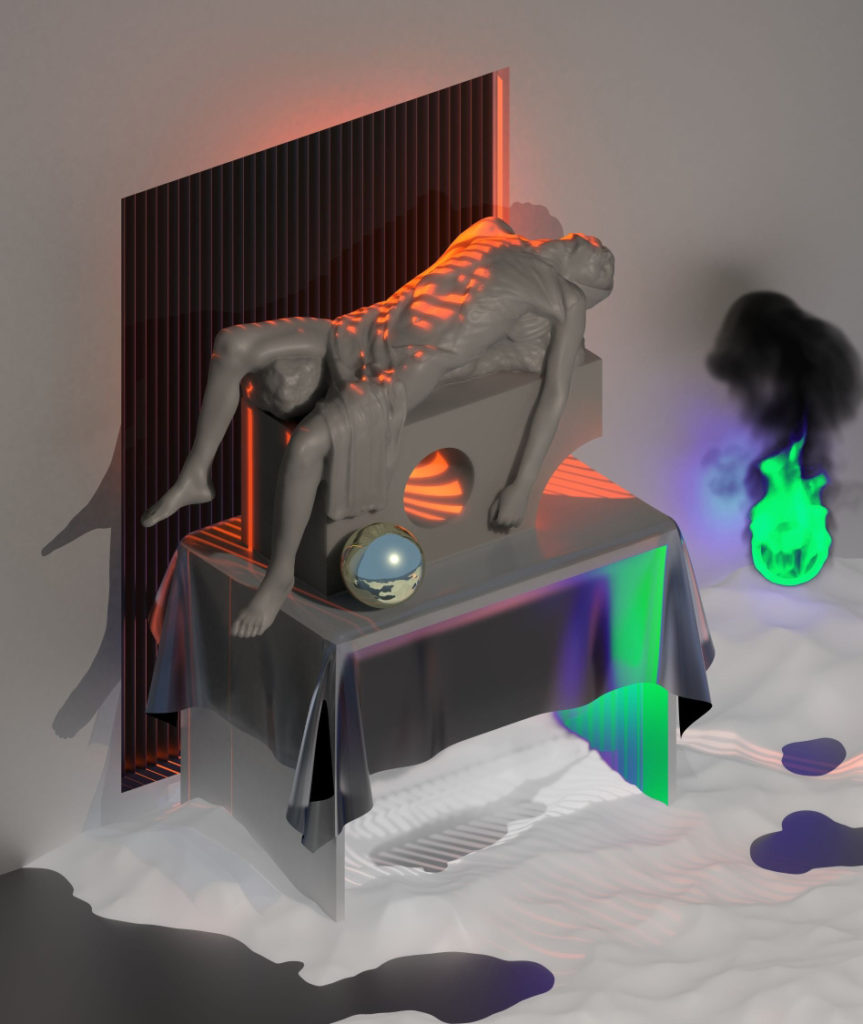
SB: You were part of the team managing the Superliquidato (SPRLQDT) gallery. How would you describe your approach to curating digital works? How important was the SPRLQDT experience for you as an artist?
GC: I’m not sure if I have a different approach to curating digital works as opposed to any other kind of work—a work is a work. With Superliquidato, what we did was mainly to build shows that we would enjoy seeing, with content we enjoyed observing; to a certain extent, we wanted to broaden some horizons related to artistic practice by gathering work from people we thought were bringing something different to the table. While it was a short-lived project in that particular form, I think it taught us a great deal about the logistics of managing a space in the context in which we were developing. One of the main aspects that I took with me from that experience, is a certain enhanced sense of responsibility in relation to my own practice and the challenges that come with affiliated functions related to artistic development. It brought with it a lot of do’s and don’ts and it clarified priorities, especially those relating to my own placement within the affiliated functions I mentioned above.
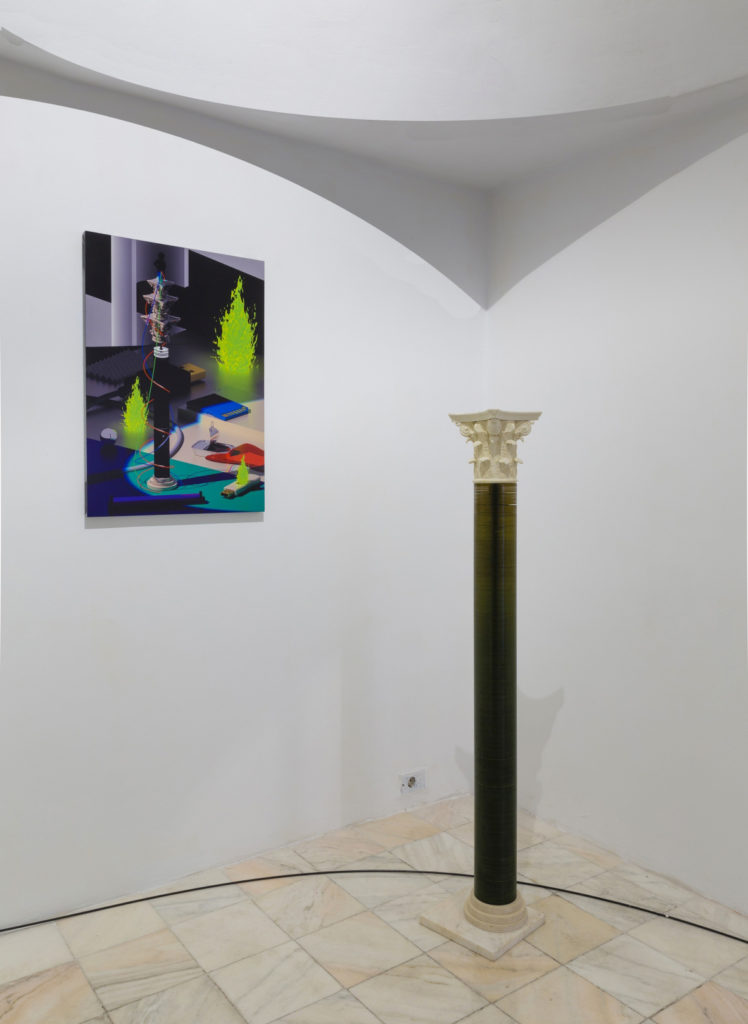
SB: Is there a specific process whereby you translate your work from the screen to the physical space? Are your projects intended for screen/the Internet only, or do you always have in mind their display in physical spaces? How do you conceive the specific exhibition format?
GC: Apart from video works, I never really created anything specifically for the Internet or the screen. The space in which I usually show my works has a considerable influence on how I exhibit the works. I like the idea of transforming that space according to parameters that kind of match the ecosystem within the works, so that, in the end, the exhibition space becomes a work in itself, a whole. I’ve done numerous site-specific projects that followed the structure that I was exploring at the time, it keeps me level. In fact, many of my 3D scenes are an idealised version of an exhibition. I like to think of them as first drafts for installations and other similar interventions… So while I do conceive the format myself, this is altered as the project moves forward. Flexibility is key and works tend to evolve massively from their state of ‘idea’ to the ‘fixed’ state in which the public gets to interact with them. Curators and technical possibilities also play a huge role in the end, because we live in circumstances in which compromise is constant not only in art, but as part of our daily lives, in their numerous facets. Work is called work because sometimes it’s your responsibility to make it work; even if it’s not the particular set-up you envisioned, there are many ways in which you can still create that vision, in spite of circumstantial difficulties.
SB: Do you think any one of your artworks is more representative for your body of works?
GC: It’s kind of a silly question, because they are all representative in one way or another. All the work I’ve done plays a role in the ongoing development of my practice. They reflect time periods of varying interests and procedures, and they tend to flow between them in a very clear way, as far as I am concerned. But I guess that the most ‘representative’ would be the ones that have been shown to the public at various events… they have the feeling of closure in a way, they tend to represent a full circle of research. Usually, the works that get to be shown represent a very, very small percentage of what it actually took to reach that point…

SB: So what happens to this other percentage, of works and bits and elements that don’t come to be shown? Do you keep them as iconographic or structural elements for other works—a backbone that you then use to take the same ideas perhaps in a different direction?
GC: That’s pretty much it, yes. I’ve had works that I’ve been sitting on for a couple of years and then a moment came when I realised that they fit right in with something. Other things get enrolled in larger projects and are now part of that… and others simply perish.
SB: If we are to look at your 2014 exhibition, The Ocean and the Friendly Shore, and your 2017 exhibition at Nicodim Gallery, Orange as the Grove, Salty as the Sea, there is an evident change in both the works on display and the general setting. The setting is, of course, quite different in terms of physical space and, whereas in 2014 you approached issues of randomness and juxtaposition, at Nicodim there is this more elaborate ‘spacing’ that echoes the atemporal dimension you sought to approach. However, the works seem to have become rather ‘painterly’. I’m not sure if you agree with this, if this is a deliberate gesture or something specific to this show alone… but this ‘painterly’ effect seems to characterise your more recent works to a much higher degree than before, when ‘collage’ or ‘cut-paste’ were the pervasive techniques.
GC: If you consider sketching and collage as a precursor to painting, I think the timeline makes sense in a way. For my 2014 show, I was still close to me graduating from college and I wanted, for the most part, to detach myself from any and all things school-related. I focused on an approach that could act as a pivotal moment in terms of how I wanted to conceive a show and how I hoped my attitude towards individual works would develop. I was relying mostly on collage and 2D—and that clearly shows in the way the show turned out. Further down the line, I drifted more and more towards 3D environments. While they still are a sort of collage in broad terms, they now inhabit the same space, they share light and digital space, which makes them come about as more seamless structures. While the ‘painterly’ effect that you mention wasn’t something I was focusing on, I attribute this leap between the two, to my personal growth, to the evolution of my work and the way in which I want to further develop it.
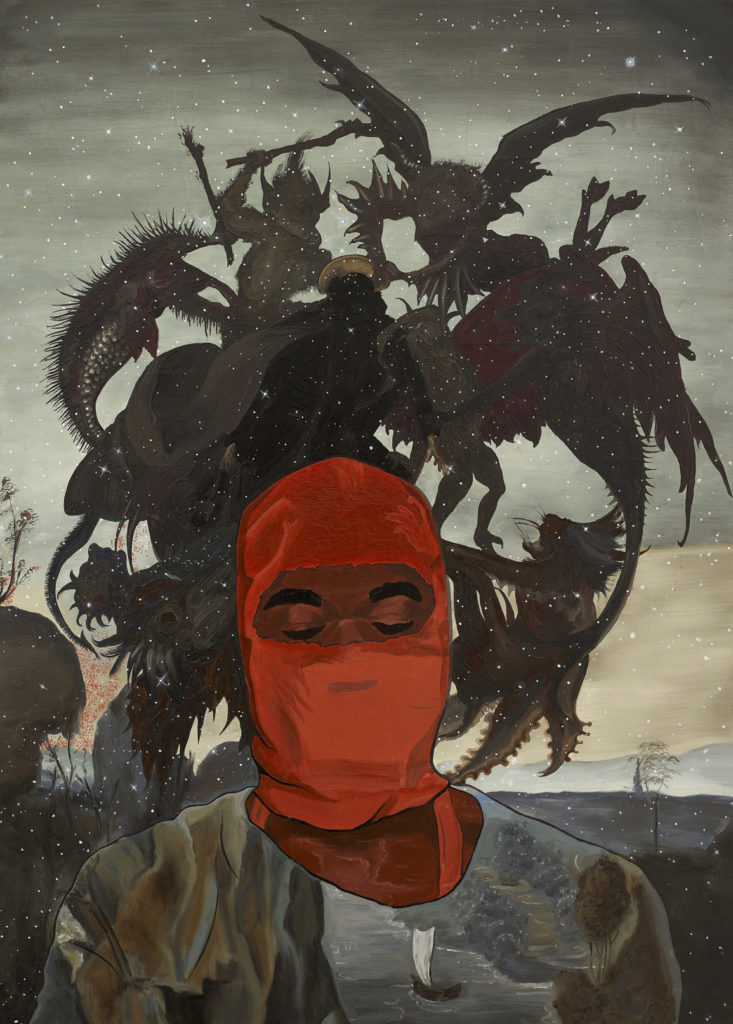
SB: It’s interesting how you experiment with more styles and seek to bring them together in your exhibitions. If we look at works such as Ancient flamingo, The Friendly Shore , the works at Nicodim, and Portrait of AAA as ZZZ, for instance— there are obviously differences in terms of style, genre, technique, or the intensity of your intervention. How do you establish the point of convergence between these works when conceiving your display?
GC: I think I already mentioned before that I like to treat spaces as I treat my works—so, taking this into consideration, at the beginning I was building the exhibition as a sort of collage made of the pieces I wanted to show; the point of convergence was very loose, as I had a tendency to leap from one point to another quite quickly. Since then, my way of reasoning is that I have certain broad themes that hold the potential to become exhibitions and the works that come to be can occupy various spots within these themes. Others are decided on location, as the show progresses and begins to take form. Right now, I rely more on pre-emptive thought. I like to place works in ideal circumstances and spaces they can occupy, I shuffle them around, I cancel them out, I bring them back—so when and if a situation occurs, I have a starting point for what that situation can become… After that, it’s basically intuition and on-spot decisions that define the final display.
SB: How important are software, hardware, or code in developing your work? How did you come to master them?
GC: Hardware and software are essential in relation to my digital work, that’s obvious. There is no going around that. But I feel that this particular type of work really gets to shine when it’s contrasted by other mediums, when it takes shape within tangible contexts. I have no relation to coding whatsoever, it was never really something I got into. All the knowledge I carry about software and hardware, I acquired it myself throughout the years, either by turning to the vast tutorial scene or by the classic trial and error method. In the end, you come to realise that most software follows the same pattern when it comes to user interfacing, so I think it’s very easy once you have a couple of tools down.
SB: Is ‘digital art’ a subject encouraged in art schools in Romania?
GC: The mere fact that you placed digital art in quotes in this question, could act as an answer. The truth is that, for the most part, art schools in Romania tend to focus on the tradition of what art is perceived to be, namely painting, drawing, sculpture, ceramics, fashion—they like the genres. It’s not discouraged as a medium when it comes to graphic design and stuff like that, but that’s where they usually draw the line. The main problem isn’t really with digital art, but with a lack of understanding artistic practice as being something that transcends these boundaries. As far as I know, most of the art schools promote this stubborn attitude with regard to the way things should be done, while completely ignoring any possibility of taking a more inclusive attitude to what could become a form of individual expression. I don’t think it’s a negative thing to be in the position of rigorous study and classical art, but at the same time, the educational status quo regarding artistic manifestation lacks the very basic principles of being able to cross the boundaries of established mediums, of creating diversity by using any tools that you choose. All in all, I think the way in which the practice is taught to students lacks flexibility and forward thinking. Fortunately, being in the age that we are in, this does not limit an inquisitive mind to pursue his/her own interests in the matter. With some degree of compromise involved, you can still navigate those waters and come out with your own forms of engagement… Who knows? Maybe in its current state, it just works as a filtering mechanism.
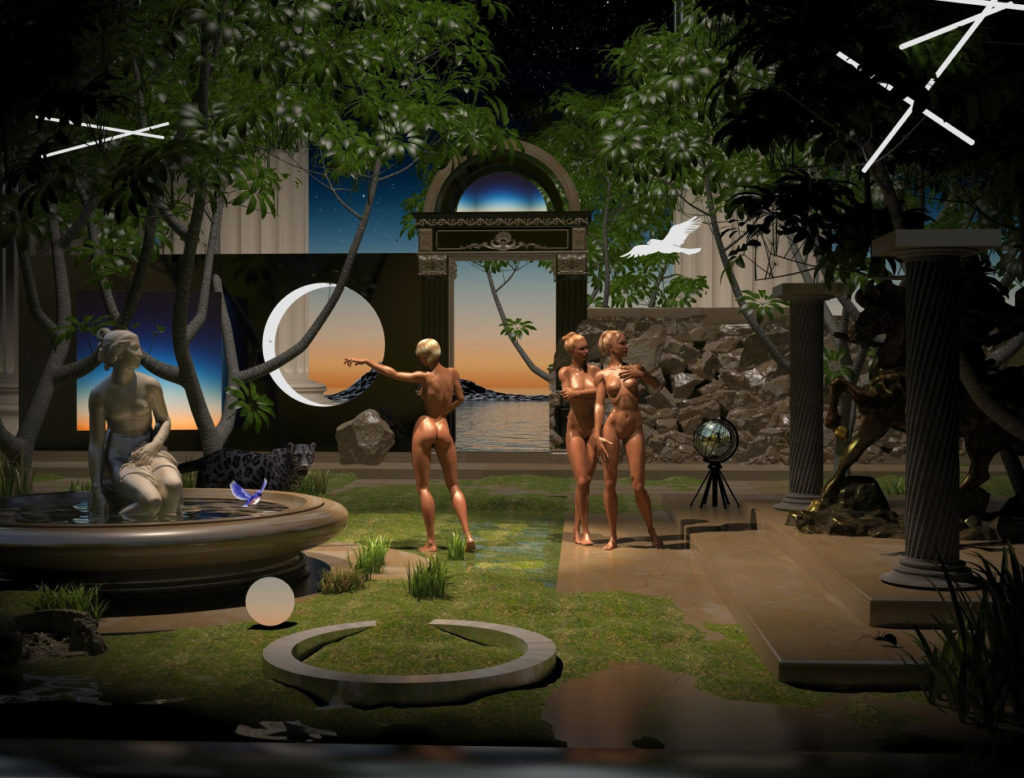
SB: Did you find any support from art galleries, institutions, or private collectors?
GC: I have been fortunate enough to receive varying degrees of support over the years and I really believe that this played a large part in me being able to continue developing my practice. Most of the people I’ve worked with have a sense of what it means to develop using this medium, but like everybody else in this particular geographical landscape, we are at a very incipient phase of development. As with many other places, I think it’s fair to say that it’s a continuous learning process. Even at a worldwide level, this sort of attitude is slowly advancing towards a better understanding.
SB: Are you represented by any gallery?
GC: I’m not currently represented by any gallery.
SB: Was your work described and categorised in any particular way by people you’ve worked with over the years, say gallerists, curators, or writers?
GC: Well yes, as I said above, people love to categorise… I mean, everybody is free to enact their own perspectives on a particular work of art, that’s what makes it work in the end. I have a high level of disdain for art that kind of takes you by the hand in order to ‘inform’ you. I like the idea that once you choose to show something, people are free to place themselves within that scenario and take from it whatever they can and will. At the same time, you as the artist are free to inform whoever comes bearing questions about the development of your practice. For the most part, I think it’s about knowing when to step in if it gets misconstrued or transformed into something that takes on connotations which are radically different from your intentions. But even then, your intervention should not come as a correction—it should come as a sort of info point.
SB: Do you think your work relates in any way specific to the local, regional, or international art scene? Or that there is something specific in the way digital media was adopted in Romania?
GC: I think people are starting to catch up with the notion that it’s not some alienated niche form of expression, nor is it that new as a principle. It’s been around for decades now and the way in which it can be utilised has been growing alongside society and technology itself. Apart from the situations in which the social and political have been engaged directly, I feel that artists in post-socialist countries have adopted digital media in very much the same way everybody else has, with curiosity and a need to explore a newly found territory in order to maximise its potential.

SB: Did the changes taking place in digital visual culture affect the local scene in any particular way? Is our relation to digital media and the Internet changing now?
GC: It definitely has an increased impact on the local scene. There are many more people who see the potential in fusing digital tools with their practice, and many more who have come to understand it as a viable visual culture ally. I think the Internet is an ever-expanding platform and that we are becoming increasingly engaged with it. starting with the number of people connected, and moving on to the way in which it develops, digital media and the Internet tend to permeate most aspects of living life. The pro’s and con’s of this situation are up for debate.
George Crîngasu (b.1988) lives and works between Rome, Italy and Cluj-Napoca, Romania. His practice focuses on data de/recontextualization, with work ranging from installation and video to print and painting. The artist’s work has been exhibited in venues such as: Nicodim Gallery, Bucharest; Art Encounters Biennial, Timișoara; Athens Digital Art Festival, Greece;Liste Art Fair, Basel.
Sabin Borș (b. 1981) is an independent editor and curator who also works as freelance layout designer for various web and print cultural projects. He is the founder and editor of the anti-utopias.com contemporary art platform and has been working for various specialised print and online media outlets in the field of art and architecture since 2009. In parallel with his Ph.D. thesis in philosophy—tackling the subject of archives, discourse, and contemporaneity—he started developing a multi-modal archival installation. The installation is intended as a critical approach to constructing cross-cultural and cross-disciplinary frameworks for the documentation, interpretation, and dissemination of contemporary art, providing alternative understandings of the socio-political foundations of art, constituent cultural differences and transitions, or superposed cultural, scientific, and technological interactions. He takes particular interest in dialogical constructions that create divergent networks of meaning between mediums, disciplines, and practices.
